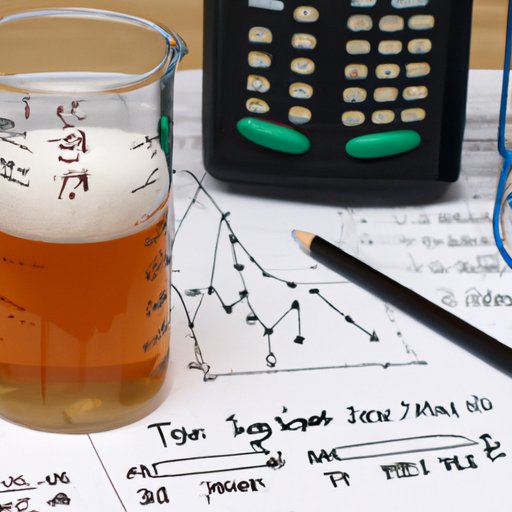Introduction
When you pick up a can or bottle of beer, wine, or liquor, you may have noticed the label includes some sort of alcohol percentage. But what does that number actually mean? This article will explore the concept of alcohol percentage and its impact on different types of drinks. You’ll learn about Alcohol by Volume (ABV), the effects of different alcohol percentages, and the relationship between ABV and strength of drinks. Finally, you’ll get a look at how to calculate alcohol content in homebrewed beer.

Explaining the Basics of Alcohol Percentage and How it Affects Beverages
The first step to understanding alcohol percentage is to know exactly what it is. Alcohol percentage is a measure of the amount of ethanol (the type of alcohol found in alcoholic beverages) present in a given volume of a drink. Usually, this is expressed as a percentage of the total liquid, so 5% alcohol would mean that 5% of the total liquid is ethanol.
So how does alcohol percentage impact drinks? Well, generally speaking, higher alcohol percentages mean stronger-tasting drinks. This means that drinks with a higher alcohol percentage will tend to be more potent and have a higher level of “kick” when consumed. On the other hand, drinks with lower alcohol percentages will usually have a milder taste and be less intense.
What is Alcohol By Volume (ABV) and Why Does it Matter?
Alcohol By Volume (ABV) is another term used to describe the amount of ethanol present in a given volume of a drink. It is typically expressed as a percentage, similar to alcohol percentage. ABV is important because it allows people to quickly and easily compare the strength of drinks and make informed decisions about which ones they want to consume.
So how does ABV affect the strength of a drink? Generally speaking, the higher the ABV, the stronger the drink. For example, a beer with an ABV of 5% will usually be much less potent than a beer with an ABV of 10%. This means that if you’re looking for a stronger-tasting beverage, you should opt for one with a higher ABV.
A Guide to the Effects of Different Alcohol Percentages
Now that you know the basics of alcohol percentage, let’s take a look at the effects of different levels of alcohol in drinks. Generally speaking, there are three main categories of alcohol levels: low-alcohol, moderate alcohol, and high-alcohol.
Low-Alcohol Beverages
Low-alcohol beverages, also known as “session beers,” are those with an alcohol percentage of 4.5% or lower. These drinks are usually light in body and flavor and are perfect for casual drinking. They tend to be easy to drink and don’t cause a strong “buzz” when consumed.
Moderate Alcohol Beverages
Moderate alcohol beverages are those with an alcohol percentage between 4.5% and 7%. These drinks tend to have a bit more body and flavor than low-alcohol beverages. They also tend to cause a slight “buzz” when consumed, but not enough to be considered overly strong.
High-Alcohol Beverages
High-alcohol beverages are those with an alcohol percentage of 7% or higher. These drinks are typically quite strong and have a distinct taste. They can cause a significant “buzz” when consumed and should be enjoyed in moderation.
Understanding the Relationship Between ABV and Strength of Drinks
Now that you know the basics of alcohol percentage and its effects on different drinks, let’s take a look at the relationship between ABV and strength of drinks. When it comes to alcoholic beverages, different types of alcohol have different levels of ABV. For instance, beer typically has an ABV of around 4-7%, while spirits like whiskey and vodka tend to have an ABV of around 40-50%.
So how do ABV and strength of drinks relate? Put simply, the higher the ABV, the stronger the drink. This means that a beer with an ABV of 10% will be much stronger than a beer with an ABV of 5%. As a result, it’s important to pay attention to the ABV of any alcoholic beverage you’re consuming, as it can have a major impact on the strength of the drink.

Looking at Alcohol Concentration Through a Chemistry Lens
If you’re interested in learning more about the science behind alcohol concentration, it’s helpful to take a look at the process from a chemistry perspective. Alcohol is created through a process called fermentation, which occurs when yeast breaks down sugar molecules into alcohol and carbon dioxide. The amount of alcohol produced depends on the amount of sugar present in the original solution, as well as the temperature and pH of the solution.
Once the fermentation process is complete, the alcohol content of the solution can be determined using a hydrometer. This device measures the density of the liquid, which can then be used to calculate the alcohol concentration of the solution. This is why brewers often use hydrometers to measure the alcohol content of their homebrewed beer.
The Pros and Cons of High-ABV Beverages
High-alcohol beverages can be great for enjoying a strong, flavorful drink. However, there are both advantages and disadvantages to be aware of. On the plus side, high-ABV beverages tend to have a rich, complex flavor that can be quite enjoyable. They also tend to have a higher level of “kick” than lower-alcohol drinks, which can make them more exciting to consume.
On the downside, high-ABV beverages can be very potent and can cause unpleasant side effects when consumed in excess. They can also be more expensive than lower-alcohol drinks, due to their higher alcohol content. As a result, it’s important to be mindful of your consumption and to enjoy these drinks in moderation.

How to Calculate Alcohol Content in Homebrewed Beer
If you’re a homebrewer, you may be wondering how to calculate the alcohol content of your beer. Fortunately, this process is fairly straightforward. All you need is a hydrometer, some distilled water, and a few other ingredients.
Ingredients Needed
- Hydrometer
- Brewpot
- Distilled Water
- Grain Bill
- Hops
- Yeast
Steps to Calculate Alcohol Content
- Fill the brewpot with your grain bill, hops, and yeast.
- Add enough distilled water to cover the ingredients.
- Stir the mixture until all of the ingredients are evenly distributed.
- Take a hydrometer reading of the mixture and record the results.
- Allow the mixture to ferment for several days.
- Take another hydrometer reading and subtract the original reading from the new reading.
- Calculate the alcohol content of the beer using the formula: (OG – FG) x 131 = %ABV.
Conclusion
In conclusion, alcohol percentage is a measure of the amount of ethanol present in a given volume of a drink. It is typically expressed as a percentage of the total liquid, and is often referred to as Alcohol By Volume (ABV). Alcohol percentage has a major impact on the strength of a drink, with higher percentages leading to stronger-tasting beverages. Different types of alcohol also have different levels of ABV, with beer typically having an ABV of 4-7% and spirits like whiskey and vodka having an ABV of 40-50%. Finally, homebrewers can calculate the alcohol content of their beer using a hydrometer and a few other ingredients.
Overall, understanding alcohol percentage is essential for making informed decisions about which beverages to consume. By being aware of the different levels of alcohol in drinks and their respective effects, you can ensure that you’re making the best choices for your health and wellbeing.
(Note: Is this article not meeting your expectations? Do you have knowledge or insights to share? Unlock new opportunities and expand your reach by joining our authors team. Click Registration to join us and share your expertise with our readers.)
